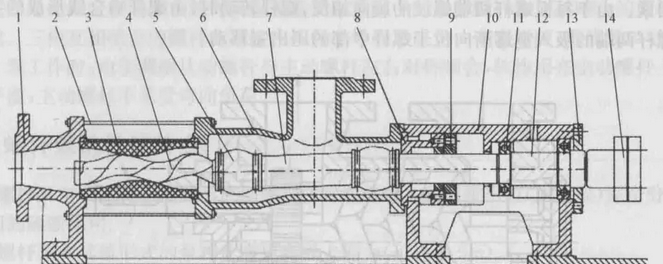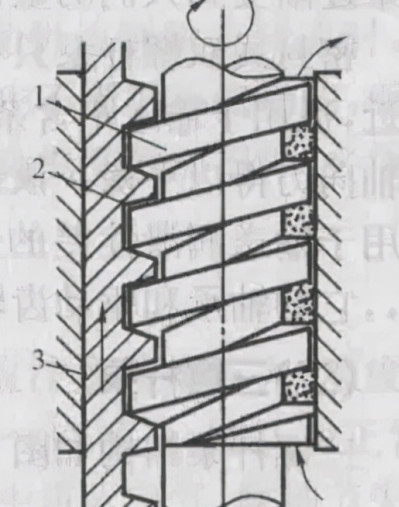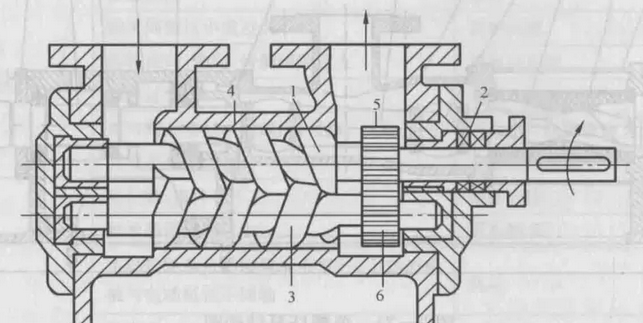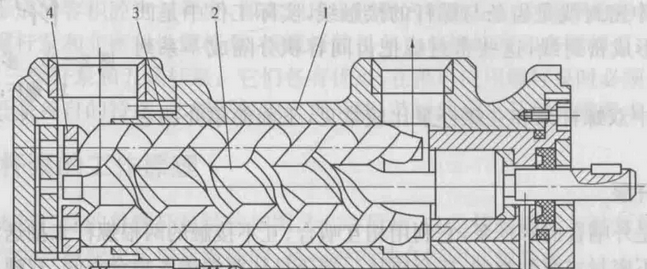Classification and performance characteristics of Progressive Cavity Pump
 Nov 04, 2021|
Nov 04, 2021| View:392
View:392There are many types of Progressive Cavity Pump, and there are usually two ways to classify them. According to the axial position of the installation of the screw is divided into vertical pumps and horizontal pumps; according to the screw and the bushing to form the volume cavity sealing degree, that is, in the theory of the suction cavity and pressure cavity separated by the degree of perfection, the screw pump will be divided into sealed screw pumps and non-sealed screw pumps; according to the number of screws into single screw pumps and multi-screw pumps, multi-screw pumps can be divided into twin screw pumps, three screw pumps and five screw pumps. They have their advantages, in the promotion of the application of screw pumps must be reasonably selected. Only by making full use of the respective characteristics of Progressive Cavity Pump can we better achieve energy saving, material saving and meet some special requirements.
01 The working principle of single Progressive Cavity Pump
The structure of the single Progressive Cavity Pump, which is widely used at present, is shown in Figure 1. It relies on the mutual engagement of the screw and the bushing to produce volume changes in the suction and discharge cavities to convey liquids, and is a kind of internal mesh closed Progressive Cavity Pump.

Figure 1 Single screw pump structure diagram
1 - discharge body; 2 - tie rod; 3 - bushing; 4 - screw; 5 - universal joint; 6 - feed body; 7 - connection shaft; 8 - packing seat; 9 - packing gland; 10 - bearing seat; 11 - bearing; 12 - drive shaft; 13 - bearing gland; 14 - coupling
The main working part of a single Progressive Cavity Pump consists of a bushing (stator) with a double-headed helical cavity and a single-headed eccentric screw (rotor) that engages in the stator cavity. When the input shaft drives the rotor through the universal joint to make a planetary rotation around the center of the stator, the special geometry of the rotor and stator creates several separate sealing cavities. The rotation of the rotor transports the medium in each sealed chamber continuously, uniformly and volumetrically from the suction side to the pressure side.
This pump also relies on the rotation of a screw to push forward the liquid, but its high and low pressure chambers are not connected. The special structure of the screw and the special bushing (made of elastic material) with an inner helical surface to cooperate, the screw and bushing to separate the liquid in the axial direction, but also in the radial direction to divide the liquid flow in two, forming a sealed cavity. Therefore, in each screw and bushing pair, the screw is a single helix, while the inner surface of the bushing is a double helix, and the direction of rotation of both is the same, i.e., the same right or left rotation.
Single Progressive Cavity Pump is suitable for conveying high viscosity, solid particles or high fibers, and requires continuous and stable pressure because the medium flows axially and uniformly.
02 Working Principle of Multi-Progressive Cavity Pump
Twin-screw, three-screw and five-screw pumps, one of which is the active screw, is a right-handed convex screw, and the rest is the driven screw, is a left-handed concave screw, the working principle is shown in Figure 2. When the screw rotates, the volume of the suction chamber increases, the pressure decreases, and the liquid enters the suction chamber along the suction pipe under the action of the pressure difference between inside and outside the pump. With the rotation of the screw, the liquid in the sealing cavity continuously and evenly along the axial movement to the discharge cavity, as the volume of the discharge cavity at one end gradually reduced, the liquid will be discharged.

Figure 2 Principle diagram of multi-screw pump
1-Screw; 2-Rigging; 3-Casing
The seal lines in Figure 2 are the contact lines between the rack and the screw. In actual operation, the concave screw and the convex screw form the seal lines, and these seal lines separate the volume between the teeth into a series of seal cavities.
Among the Multi-Progressive Cavity Pump, Double Progressive Cavity Pump and Triple Progressive Cavity Pump are more common, and their structural features are briefly described below.
● Double Progressive Cavity Pump
Twin Progressive Cavity Pump is an externally engaged cavity pump that uses two screws that engage each other and do not touch each other to pump liquid. There are two types of Twin Progressive Cavity Pumps, sealed and unsealed; according to whether the medium enters the meshing space from one end or both ends, Twin Progressive Cavity Pumps are divided into two types of structures, double suction and single suction. Figure 3 shows a non-sealed double-suction twin-screw pump. The pump body is equipped with two left and right single-headed threaded screw, the active screw driven by the power machine rotation, driven by synchronous gear driven by the driven screw rotation. There is a gap between the two screws and between the screw and the pump body, and the gap is ensured by the gears and bearings. The size of the clearance depends on the liquid viscosity, working pressure and other factors. Due to the opposite direction of rotation of the threads at each end of the screw, the pump working chamber formed by the screw engagement line gradually moves from the suction chamber located at both ends of the screw to the pressure chamber located in the middle of the screw.

Figure 3 Twin-screw pump structure diagram
1 - active screw; 2 - stuffing box; 3 - driven screw; 4 - pump casing; 5, 6 - gear
Not sealed Progressive Cavity Pump, its high pressure, low pressure working chamber is not tightly separated, its volumetric efficiency is lower than the sealed Progressive Cavity Pump, especially in high pressure, this difference is more significant. From economic considerations, not sealed screw pump is not applicable to the high-pressure range, but with the method of taking a special screw type line, it can effectively expand its range of application to the pressure. And this pump screw and the bushing does not contact, screw and screw is not in close contact with each other, suitable for transporting high viscosity, non-lubricated liquid, or multi-phase medium containing tiny solid phase impurities. Because the degree of wear and tear of the non-sealed pump is smaller than the sealed screw pump, long service life, which is not sealed twin screw pump gradually by people's attention, the number of production and application of the main reason for the growing range.
Sealed Twin Progressive Cavity Pump has only two screws, but meets all sealing conditions. Its composition and characteristics are similar to those of a three-screw pump, and it is suitable for conveying clean, lubricious liquids without impurities and can be used in higher pressure situations. The double-suction structure allows the axial force on the screw to be balanced. The pump's drive gear and the bearing of the supporting screw are located outside the pump cavity, which is an external bearing structure and can be used to convey poorly lubricated media. For conveying non-corrosive and well-lubricated media, the built-in bearing type structure can be used, where the bearing and the driving gear are located inside the pump cavity, thus reducing the number of shaft seals of the pump.
Triple Progressive Cavity Pump
The structure of the Triple Progressive Cavity Pump is shown in Figure 4.

Figure 4 Three screw pump structure diagram
1-Back cover; 2-Case (bushing); 3-Active screw; 4-Driven screw; 5-Front cover; 6-Thrust bearing
It is mainly composed of the bushing fixed in the pump body and the active screw inserted in the pump cylinder and the two driven screws engaged with it. The three intermeshing screws form a sealing chamber in the pump cylinder according to each lead, resulting in a seal between the suction and discharge ports. When the pump is in operation, the two driven screws are symmetrically engaged with the active screw, so the radial forces acting on the active screw are completely balanced and the active screw is not subjected to bending loads.
03 Performance Features of Progressive Cavity Pump
(1) The spiral sealing line formed by the contact between the stator and rotor of the Progressive Cavity Pump completely separates the suction chamber from the discharge chamber (pressure chamber), making the pump have the isolating effect of a valve.
(2) Progressive Cavity Pump has a higher suction capacity (up to 8.5m) compared to other forms of pumps.
(3) Progressive Cavity Pump can realize multi-phase mixing of liquid, gas and solids.
(4) Progressive Cavity Pump does not change volume when the fluid flows in the pump, there is no turbulence, churning and pulsation.
(5) Progressive Cavity Pump conveys medium viscosity up to 3×106mPa.S and solids content up to 60%.
(6) The volume formed by the elastic stator of Progressive Cavity Pump can effectively reduce the abrasion when conveying media containing solid particles.
(7) The flow rate of Progressive Cavity Pump is proportional to the rotational speed, and the flow rate can be automatically adjusted with the help of the speed regulator.
(8) Progressive Cavity Pump is controlled by constant pressure to prevent dry rotation.



